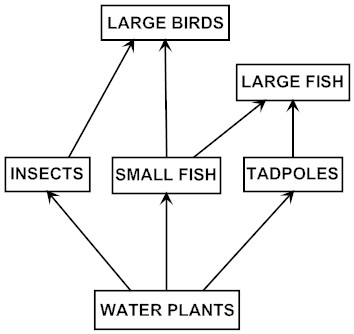Item IE019016: Changes in a population in a food web (large fish) can affect the population of its prey (tadpoles).
The diagram below shows the feeding relationships between populations of plants and animals in and around a pond. The arrows point from the organisms being eaten to the organisms that eat them.

More people than usual go fishing at the pond this year and take a lot of the large fish out of the pond. Using only the relationships between the plants and animals shown in the diagram, which of the following could happen and why?
- The number of tadpoles is likely to increase because there are fewer large fish to eat the tadpoles.
- The number of large birds is likely to stay the same because large fish and large birds are not connected by an arrow in the diagram.
- The number of small fish is likely to decrease because with fewer large fish for the large birds to eat, the large birds would have to eat more small fish.
- Only the number of large fish is likely to change because only large fish were taken out of the pond.
Answer Choice |
Overall |
Grades |
Gender |
Primary Language |
||||
|---|---|---|---|---|---|---|---|---|
| n = 1399 |
6–8 n = 790 |
9–12 n = 607 |
Male n = 653 |
Female n = 712 |
English n = 1263 |
Other n = 102 |
||
| A. | The number of tadpoles is likely to increase because there are fewer large fish to eat the tadpoles. | 65% | 61% | 69% | 65% | 64% | 65% | 57% |
| B. | The number of large birds is likely to stay the same because large fish and large birds are not connected by an arrow in the diagram. | 11% | 12% | 11% | 10% | 12% | 10% | 17% |
| C. | The number of small fish is likely to decrease because with fewer large fish for the large birds to eat, the large birds would have to eat more small fish. | 15% | 17% | 13% | 14% | 16% | 15% | 18% |
| D. | Only the number of large fish is likely to change because only large fish were taken out of the pond. | 9% | 11% | 7% | 10% | 8% | 9% | 9% |

